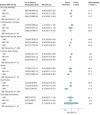Association of Blood Pressure Lowering With Mortality and Cardiovascular Disease Across Blood Pressure Levels: A Systematic Review and Meta-analysis
- PMID: 29131895
- PMCID: PMC5833509
- DOI: 10.1001/jamainternmed.2017.6015
Association of Blood Pressure Lowering With Mortality and Cardiovascular Disease Across Blood Pressure Levels: A Systematic Review and Meta-analysis
Abstract
Importance: High blood pressure (BP) is the most important risk factor for death and cardiovascular disease (CVD) worldwide. The optimal cutoff for treatment of high BP is debated.
Objective: To assess the association between BP lowering treatment and death and CVD at different BP levels.
Data sources: Previous systematic reviews were identified from PubMed, the Cochrane Database of Systematic Reviews, and the Database of Abstracts of Reviews of Effect. Reference lists of these reviews were searched for randomized clinical trials. Randomized clinical trials published after November 1, 2015, were also searched for in PubMed and the Cochrane Central Register for Controlled Trials during February 2017.
Study selection: Randomized clinical trials with at least 1000 patient-years of follow-up, comparing BP-lowering drugs vs placebo or different BP goals were included.
Data extraction and synthesis: Data were extracted from original publications. Risk of bias was assessed using the Cochrane Collaborations assessment tool. Relative risks (RRs) were pooled in random-effects meta-analyses with Knapp-Hartung modification. Results are reported according to PRISMA guidelines.
Main outcomes and measures: Prespecified outcomes of interest were all-cause mortality, cardiovascular mortality, major cardiovascular events, coronary heart disease (CHD), stroke, heart failure, and end-stage renal disease.
Results: Seventy-four unique trials, representing 306 273 unique participants (39.9% women and 60.1% men; mean age, 63.6 years) and 1.2 million person-years, were included in the meta-analyses. In primary prevention, the association of BP-lowering treatment with major cardiovascular events was dependent on baseline systolic BP (SBP). In trials with baseline SBP 160 mm Hg or above, treatment was associated with reduced risk for death (RR, 0.93; 95% CI, 0.87-1.00) and a substantial reduction of major cardiovascular events (RR, 0.78; 95% CI, 0.70-0.87). If baseline SBP ranged from 140 to 159 mm Hg, the association of treatment with mortality was similar (RR, 0.87; 95% CI, 0.75-1.00), but the association with major cardiovascular events was less pronounced (RR, 0.88; 95% CI, 0.80-0.96). In trials with baseline SBP below 140 mm Hg, treatment was not associated with mortality (RR, 0.98; 95% CI, 0.90-1.06) and major cardiovascular events (RR, 0.97; 95% CI, 0.90-1.04). In trials including people with previous CHD and mean baseline SBP of 138 mm Hg, treatment was associated with reduced risk for major cardiovascular events (RR, 0.90; 95% CI, 0.84-0.97), but was not associated with survival (RR, 0.98; 95% CI, 0.89-1.07).
Conclusions and relevance: Primary preventive BP lowering is associated with reduced risk for death and CVD if baseline SBP is 140 mm Hg or higher. At lower BP levels, treatment is not associated with any benefit in primary prevention but might offer additional protection in patients with CHD.
Conflict of interest statement
Figures



Comment in
-
Whom to Treat for High Blood Pressure-Time for a Precision Approach.JAMA Intern Med. 2018 Jan 1;178(1):37-38. doi: 10.1001/jamainternmed.2017.7853. JAMA Intern Med. 2018. PMID: 29297011 No abstract available.
-
Review: In primary prevention, BP-lowering treatment reduces major CV events in patients with SBP ≥ 140 mm Hg.Ann Intern Med. 2018 Feb 20;168(4):JC15. doi: 10.7326/ACPJC-2018-168-4-015. Ann Intern Med. 2018. PMID: 29459952 No abstract available.
-
Questionable Conclusions Regarding Blood Pressure End Points.JAMA Intern Med. 2018 Apr 1;178(4):574-575. doi: 10.1001/jamainternmed.2018.0026. JAMA Intern Med. 2018. PMID: 29610871 No abstract available.
-
Questionable Conclusions Regarding Blood Pressure End Points.JAMA Intern Med. 2018 Apr 1;178(4):575. doi: 10.1001/jamainternmed.2018.0340. JAMA Intern Med. 2018. PMID: 29610880 No abstract available.
-
Questionable Conclusions Regarding Blood Pressure End Points-Reply.JAMA Intern Med. 2018 Apr 1;178(4):575-576. doi: 10.1001/jamainternmed.2018.0029. JAMA Intern Med. 2018. PMID: 29610886 No abstract available.
-
Blood pressure-lowering treatment lowers mortality and cardiovascular disease risk, but whether effects differ at an arbitrary threshold of 140 mm Hg systolic blood pressure requires further research.BMJ Evid Based Med. 2018 Oct;23(5):189-190. doi: 10.1136/bmjebm-2018-110934. Epub 2018 May 24. BMJ Evid Based Med. 2018. PMID: 29794113 No abstract available.
References
-
- Weber MA, Schiffrin EL, White WB, et al. . Clinical practice guidelines for the management of hypertension in the community a statement by the American Society of Hypertension and the International Society of Hypertension. J Hypertens. 2014;32(1):3-15. - PubMed
-
- Mancia G, Fagard R, Narkiewicz K, et al. ; Task Force Members . 2013 ESH/ESC Guidelines for the management of arterial hypertension: the Task Force for the Management of Arterial Hypertension of the European Society of Hypertension (ESH) and of the European Society of Cardiology (ESC). J Hypertens. 2013;31(7):1281-1357. - PubMed
-
- James PA, Oparil S, Carter BL, et al. . 2014 evidence-based guideline for the management of high blood pressure in adults: report from the panel members appointed to the Eighth Joint National Committee (JNC 8). JAMA. 2014;311(5):507-520. - PubMed
Publication types
MeSH terms
Substances
LinkOut - more resources
Full Text Sources
Other Literature Sources
Medical

